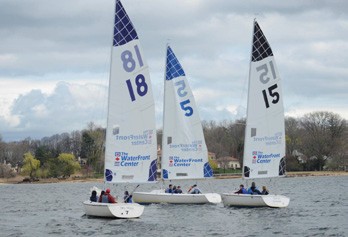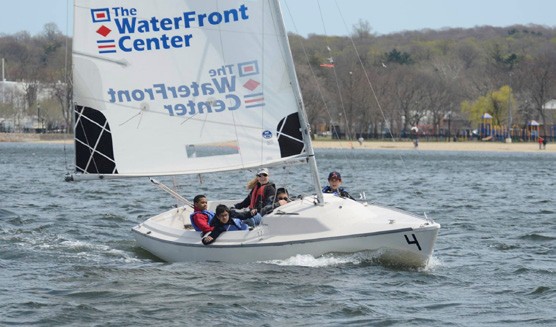By Margaret Reddington
 Folding a paper airplane during class is frowned upon. Taking that paper airplane and using the teacher as a target to measure its precision is grounds for a trip to the principal’s office…well, except during a STEAM (Science, Technology, Engineering, Arts, Math) lesson at The WaterFront Center in Oyster Bay, NY.
Folding a paper airplane during class is frowned upon. Taking that paper airplane and using the teacher as a target to measure its precision is grounds for a trip to the principal’s office…well, except during a STEAM (Science, Technology, Engineering, Arts, Math) lesson at The WaterFront Center in Oyster Bay, NY.
Students from Friends Academy and LuHi enjoyed an early spring breeze on Oyster Bay’s West Harbor. © The WaterFront Center
Sixth through eighth grade students from Friends Academy in Locust Valley and LuHi (Long Island Lutheran Middle & High School) in Brookville were challenged to use the knowledge they acquired about airfoils, lift, and Bernoulli’s Principle to construct a paper airplane that could accurately fly a distance and hit The WaterFront Center’s STEAM Coordinator, Michael Donato. Through creative, hands-on lessons like this one and sailing in West Harbor, students from each school had a weeklong meaningful experience teaching them about the wind, from how it’s measured to how it’s used to its impact on daily life.
The day for the STEAM students was broken down into two parts. Groups participated in an interactive classroom portion for half of the day. While in the classroom, students learned about how wind is measured. Students spoke about the Beaufort Scale to estimate the force of the wind. They also discussed knots and miles per hour, the difference between both measurements, and converted from one to the other.
Anemometers are devices used to measure wind speed. Instead of just learning about them, the students constructed their own with simple household supplies. A pencil, a pin, four cups, a marker, and tape are all that’s needed to make an anemometer. After they were built, the students calibrated their wind speed measuring devices and tested them on land and at sea.
 Trading in desks for 23-foot Sonars and leaving classroom walls behind for West Harbor, the students spent the other half of their days at The WaterFront Center sailing. They got to see the wind in action. Instructors taught the students about points of sail, sail shape, and parts of the boat. Understanding sail trim allows students to see how correctly reading the wind and adjusting the sails accordingly affects the speed of the boat. Needless to say, the students loved this.
Trading in desks for 23-foot Sonars and leaving classroom walls behind for West Harbor, the students spent the other half of their days at The WaterFront Center sailing. They got to see the wind in action. Instructors taught the students about points of sail, sail shape, and parts of the boat. Understanding sail trim allows students to see how correctly reading the wind and adjusting the sails accordingly affects the speed of the boat. Needless to say, the students loved this.
After learning about the wind and the fundamentals of sailing, students put their new knowledge in action aboard The Waterfront Center’s Sonars. © The WaterFront Center
Just in case points of sail, sail shape, parts of the boat, tying knots, miles per hour, nautical miles per hour, Bernoulli’s Principle, the Beaufort Scale, cardinal directions, anemometers, wind speed, airfoils…wasn’t enough, the students also had some time to learn about local marine life in a touch tank. They learned about sea stars, horseshoe crabs, hermit crabs, sea snails, oysters, and other local marine life while getting a chance to hold and closely observe each invertebrate.
Friends Academy and LuHi students had great weeks at The WaterFront Center, filled with hands-on, exciting lessons. For more information about STEAM programming, contact Michael Donato at 516-922-7245 or Michael@TheWFC.org.
Margaret Reddington is The WaterFront Center’s Program Director.




